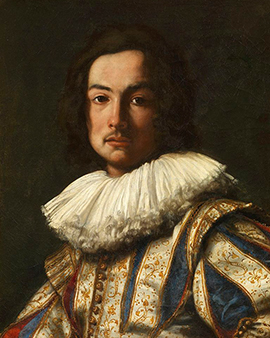The Florentine Stefano della Bella was an important draughtsman and etcher of the 17th century. His works have influenced many European artists. As a child he learned to draw and the art of engraving from a goldsmith in Florence. In the following years he copied works by Jacques Callot, among others. The artist came from Nancy in Lorraine. Callot was known for his drawings and etchings which he made for the court of the Medici family. Remigio Cantagallina, Jacques Callot's teacher, taught Stefano della Bella and supported his education. della Bella's work was strongly influenced by Callots masterly figurative representations. Stefano della Bella expanded his artistic skills in various studios in Florence. Besides drawing, he also devoted himself to painting. Callots teacher put him in contact with Cesare Dandini, who gave Stefano della Bella additional training in the art of painting. In 1632 della Bella created the figure of Copernicus for the edition Dialogo sopra i due massimi sistemi by Galileo Galilei. Today's art historians suspect that the artist did not create an individual portrait, but an archetype. He drew Copernicus in the posture of a scholar typical of the time.
Stefano della Bella was given the opportunity to work in Rome by the de Medici family, where he also distinguished himself through his exceptional skills. He deepened his knowledge of painting and made numerous etchings. Masterly views of Rome, Tivoli and the Roman Campagna were created. Della Bella captured Roman ruins and interesting street scenes in his drawings. He also created sea views and his first topographical works. Finally, the artist took the special opportunity to join a legation travelling to the French court. The legation sent official congratulations on the birth of the future Sun King Louis XIV. Della Bella was commissioned by Cardinal Richelieu to paint a representation of the besieged city of Arras. This was the prelude to further architectural views of the artist. della Bella also made drawings and etchings for the theatre. For example, he designed the title page for the opera La Finta Pazza and drew ballets of animals that appeared between the scenes.
Della Bella created more than a thousand drawings and etchings during his life. His motifs were war battles, military depictions and hunting scenes. He also produced maps, sea charts and realistic depictions of animals. His drawing of an elephant dying in Florence is still known today. della Bella's work also includes entertaining capriccios. The playful drawings were first introduced to the art of etching by Jacques Callot. The highlight of della Bella's creative power was his honorary admission to the Accademia degli Apasti, an important literary circle in Florence. Stefano della Bella spent the last years of his life in Florence, where he gave drawing lessons to the son of the Grand Duke of Tuscany. The artist died in 1664 in his home town.
×





.jpg)
.jpg)
.jpg)
.jpg)
.jpg)
.jpg)
.jpg)
.jpg)
.jpg)
.jpg)
.jpg)
.jpg)
.jpg)
.jpg)
.jpg)
.jpg)
.jpg)
.jpg)
.jpg)
.jpg)
.jpg)
.jpg)
.jpg)
.jpg)
.jpg)
.jpg)
.jpg)
.jpg)
.jpg)
.jpg)
.jpg)
.jpg)
.jpg)
.jpg)
.jpg)
.jpg)
.jpg)
.jpg)
.jpg)
.jpg)
.jpg)
.jpg)
.jpg)
.jpg)
.jpg)
.jpg)
.jpg)
.jpg)
.jpg)
.jpg)
.jpg)
.jpg)
.jpg)
.jpg)
Vues_de_-_(MeisterDrucke-1361400).jpg)
Vues_de_-_(MeisterDrucke-1361400).jpg)
.jpg)
.jpg)
.jpg)
.jpg)
.jpg)
.jpg)
.jpg)
.jpg)
.jpg)
.jpg)
.jpg)
.jpg)
.jpg)
.jpg)
.jpg)
.jpg)
.jpg)
.jpg)
.jpg)
.jpg)
.jpg)
.jpg)
.jpg)
.jpg)
.jpg)
.jpg)
.jpg)
.jpg)
.jpg)
.jpg)
.jpg)
.jpg)
.jpg)
.jpg)
.jpg)
.jpg)
.jpg)
.jpg)
.jpg)
.jpg)
.jpg)
.jpg)
.jpg)
.jpg)
.jpg)
.jpg)
.jpg)
.jpg)
.jpg)
.jpg)
.jpg)
.jpg)
.jpg)
.jpg)
.jpg)
.jpg)
.jpg)
.jpg)
.jpg)
.jpg)
.jpg)
.jpg)
.jpg)
.jpg)
.jpg)
.jpg)
.jpg)
.jpg)
.jpg)
.jpg)
.jpg)
.jpg)
.jpg)
.jpg)
.jpg)
.jpg)
.jpg)
.jpg)
.jpg)
.jpg)
.jpg)
.jpg)
.jpg)
.jpg)
.jpg)
.jpg)
.jpg)
.jpg)
.jpg)
.jpg)
.jpg)
.jpg)
.jpg)
.jpg)
.jpg)
.jpg)
.jpg)
.jpg)
.jpg)
.jpg)
.jpg)
.jpg)
.jpg)
.jpg)
.jpg)
.jpg)
.jpg)
.jpg)
.jpg)
.jpg)
.jpg)
.jpg)
.jpg)
.jpg)
.jpg)
.jpg)
.jpg)
.jpg)
.jpg)
.jpg)
.jpg)
.jpg)
.jpg)
.jpg)
.jpg)
.jpg)
 - (MeisterDrucke-1520).jpg)
 - (MeisterDrucke-1520).jpg)
.jpg)
.jpg)
.jpg)
.jpg)
.jpg)
.jpg)
.jpg)
.jpg)
.jpg)
.jpg)
.jpg)
.jpg)
.jpg)
.jpg)
.jpg)
.jpg)






